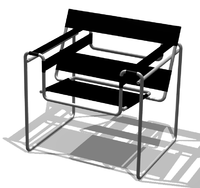A-level Graphic Products/Edexcel/Unit 3 :Designing for the Future/Design in context/Influences of design history on developments of products
Jump to navigation
Jump to search

A timeline of art movements covered by Edexcel in Graphic Products. 
Arts and crafts example by William Morris. 
An example of Art Nouveau by Charles Rennie Mackintosh 
An example of Bauhaus 
Wassily chair, created by Marcel Breuer 
An example of Art Deco by Eileen Gray 
A Streamlining example by Raymond Loewy 
An example of Post-modernism by Philippe Starck

Arts and Crafts (1850-1900)
[edit | edit source]
Key points:
- Items need to be fit for purpose (function is important)
- Arts and Craft designers were against industrialisation.
Style:
- Simplicity.
- Made from natural materials, based around nature.
- Colour and texture. Colour added 'unity' and 'focus.' Only natural textures were used: wood, stone, wool, linen etc.
- Splendour - They experimented with different materials and techniques, this led to unusual designs.
William Morris (1834-1896)
[edit | edit source]Key points:
- He was a poet, writer, designer, innovator in the arts and crafts movement and a socialist
- He help found Morris, Marshall, Faulkner & Co.
- He worked with stained glass, carving, furniture, wallpaper, carpets and tapestries
- He had strong socialist viewed which got him arrested once; these view influenced what he created.
Art Nouveau (1890-1905)
[edit | edit source]
Key points:
- Started in France, Paris
- A form of bridge between Arts and Craft and Modernism; old styles and values sat alongside new ones.
- The Languid line
- New aesthetic views for a new urban lifestyle.
- They were for mass-production
- Used in architecture, glass, jewellery, fabrics and wallpaper
Style:
- Curvy lines and flowers
- Hand-crafted
- Use of glass and wrought iron
- Feminine form
- Influences by other cultures - Japanese, Celtic,[1] Arabian,[2] ancient Greek.
Charles Rennie Mackintosh (1868-1928)
[edit | edit source]Key points:
- He was British, born is Glasgow
- He was an architect and he studied at Glasgow School of Art
- He mixed Art Nouveau with Scottish Architecture
Modernism (1900-1930)
[edit | edit source]Key points:
- Celebrated technology and the mechanised industry.
- Different variation appeared around Europe: Bauhaus in Germany, De Stijl in the Netherlands, Constructivism in Russia and Futurism in Italy.
- Liked mass-production
Style:
- Less is more
- Machine Aesthetic
- Rejected the old natural style/aesthetic.
Bauhaus Modernism (1919-1933)
[edit | edit source]

Note: All notes on Bauhaus are inherit all notes from Modernism.
Key points:
- Created in Germany, just before WW2, after WW1
- Bauhaus means "House for building."
- Things need to be functional, highest priority
- Reduction in decorative frills.
Style:
- Form follow Function
- Geometrically pure, straight lines
Marcel Breuer (1902-1981)
[edit | edit source]Key points:
- He liked the combination of art and technology.
- He's famously known for his 'Wassily' chair.
- The 'Wassily' chair was only possible because a German manufacturer had just recently perfected the art of mass-produced bending of metal tubes.
- He then immigrated to the USA where he obtained a professorship in School of Design at Harvard
Art Deco (1925-1939)
[edit | edit source]
Key points:
- Popular modernism
- It's a reaction to post-war (WW1)
- In favour of a mechanical modern world.
Style:
- Symmetry and repetition
- Zig-zagged geometric patterns
- Inspired by ancient Egypt.
- Sharp-edges
- Bright Colours
- Use of expensive materials
Eileen Gray (1879-1976)
[edit | edit source]Key Points:
- Went to Slade school of Fine arts in London.
- Like Japanese/French art styles at the time.
- She started with art, then moved onto architecture.
- Inspired by Marcel Breuer.
Streamlining (1935-1955)
[edit | edit source]
Key Points:
- Consumerism and Style
- New prosperity and widened consumer choice
- Celebrating speed and efficiency
- People at the time were hyped about the future, air travel and space exploration.
Style:
- Aerodynamics
- Tear-drop shape
- Futuristic style
Raymond Loewy (1893-1986)
[edit | edit source]- Born in France, spent most of his time in the USA.
- Influenced by the American life-style.
- He likes "Beauty through Simplification."
- His work mixed Art Deco with Streamlining
- He worked with a lot of multinational companies like NASA where he was later employed at.
- He spent time streamlining many items
- Streamlining allowed for greater speed and less drag.
Post-Modernism - New Design Style (1975-Present)
[edit | edit source]
We currently live in a post-modernism world, this means that anything you see that's not based upon a past movement, or from another culture is post-modernism. Key points:
- Opposes Modernism
- They think 'More is more' rather than the Modernism 'Less is more', they think 'Less is bore!'
Style:
- Humour and personality
- Retro Design
- Deconstruction
Philippe Starck (1949-Present)
[edit | edit source]Key points:
- He's a French designer
- He's all for mass-production, he had chair and toothbrushes mass-produced
- He's even produced a mouse for Microsoft